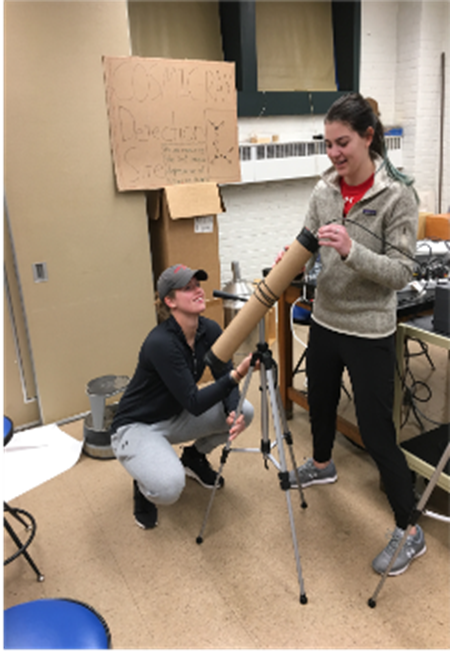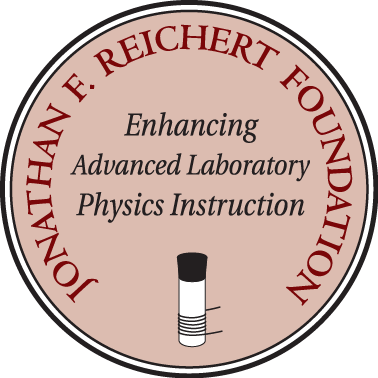- Home
- What We Do
- Laboratory Immersions
- Immersions 2024
- Imm2024Muhlenberg_MuonTelescope
Muhlenberg College, Allentown PA
Angular Dependence of Muon Rates using a Muon Telescope:
High Energy Physics with Low-Cost Detectors
June 20, 2024 to June 22, 2024
Number of setups available: 2
Maximum number of participants: 4
------------------------------------------------------------------------------------------------------------------------------------------
 While it is impossible to build the Large Hadron Collider or Brookhaven National Laboratory’s Relativistic Heavy Ion Collider (RHIC) in an undergraduate laboratory, one can use some of the same detector technologies employed at those facilities to measure the properties of high energy particles that surround us. Muons are very similar to electrons, but have about 200 times the mass. They are often created from the collision of cosmic rays (frequently high energy protons) with atoms in our upper atmosphere.
While it is impossible to build the Large Hadron Collider or Brookhaven National Laboratory’s Relativistic Heavy Ion Collider (RHIC) in an undergraduate laboratory, one can use some of the same detector technologies employed at those facilities to measure the properties of high energy particles that surround us. Muons are very similar to electrons, but have about 200 times the mass. They are often created from the collision of cosmic rays (frequently high energy protons) with atoms in our upper atmosphere.
Thus, cosmic ray muons provide an easily accessible source of high energy particles for experiments in the undergraduate laboratory. The activities we have developed culminate in the measurement of muon rates as a function of their direction (angle from the zenith) and a comparison of these rates with a commonly accepted parameterization. Fundamental experimental techniques, such as coincidence counting and the proper assessment of counting statistics, will be applied. The instruments we build will also allow the measurement of the muon lifetime, a classic experiment in the advanced lab canon.
In addition to the pivotal role played by cosmic rays in the history of particle physics and in a variety of cutting-edge ground and space-based experiments, cosmic ray muons are routinely used to research detector technologies and commission new detectors.
In our advanced lab, students build the low cost cosmic ray “telescope” and signal processing electronics themselves. Each muon telescope consists of two cylindrical plastic scintillators, each mated to a silicon photomultiplier (SiPM). This configuration is used for coincidence counting. The guiding principles in the design of the activities include: Student construction of the apparatus, use of modern detector technologies (for example, the SiPMs), implementation of the electronics in an open way that can be altered by the students (thus the use of solderless breadboards instead of printed circuit boards for most of the electronics), and low cost (the cost of a single setup is about $300). In addition, many parts of the detector are produced by low cost 3D printers, providing opportunities for students to design and produce parts themselves.
Workshop participants will start by initiating data taking runs with completed muon telescopes, and progress to building muon telescopes themselves as they acquire data with the prebuilt instruments. They will construct muon telescopes, design and assemble the data acquisition electronics, and analyze data from both the preconstructed muon telescopes and the ones they have built. Workshop participants are welcome to keep the data acquisition electronic circuits they develop (with the exception of the SiPM circuit boards).
Host and Mentor: 
Brett Fadem is a Professor of Physics at Muhlenberg College. In addition to teaching courses across the undergraduate physics curriculum and physics classes for non-science majors, he and his students perform research with the sPHENIX collaboration, a group of scientists who have built a large detector on the Relativistic Heavy Ion Collider ("RHIC") ring at Brookhaven National Laboratory. The quark-gluon plasma, a state of matter in which protons and neutrons melt into their constituents (and the state of "nuclear" matter in the universe microseconds after the big bang) was discovered at RHIC in 2005. In recent years, he has focused his attention on developing low-cost particle detectors for the undergraduate lab that are based on some of the same principles as the cutting-edge detectors at RHIC and the LHC. Most, recently, he completed construction of a small astronomical observatory for the College. For nearly ten years between high school and college, Fadem pursued an acting career in New York City, where he was trained by Uta Hagen and Herbert Berghof. He also enjoys playing violin.
Please note that the Jonathan F. Reichert Foundation has established a grant program
to help purchase apparatus used in Laboratory Immersions. Limitations
and exclusions apply, but generally speaking the Foundation may support
up to 50% of the cost of the required equipment.




